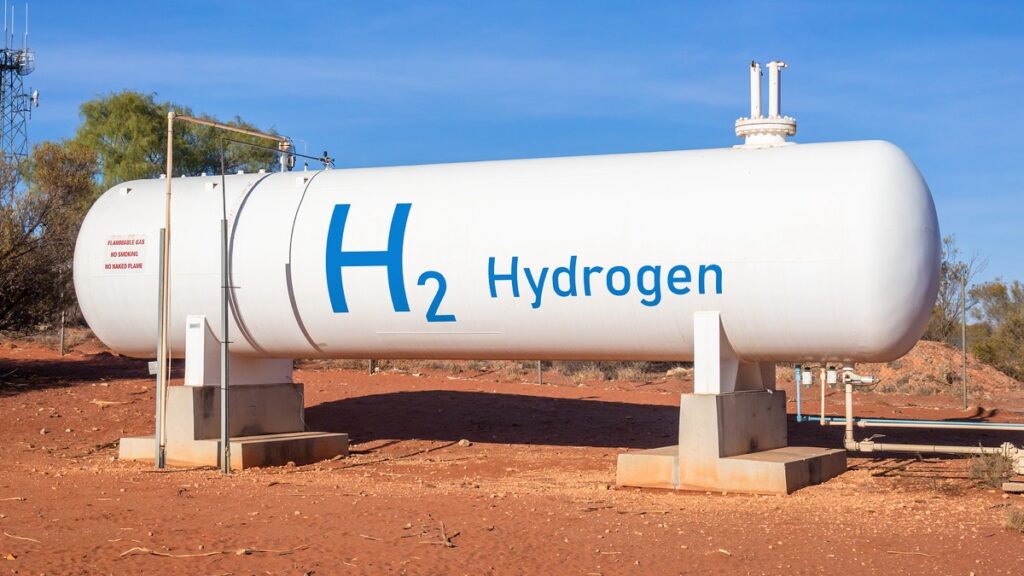Fuel is an everyday necessity; however, the most commonly used fuels are petrochemicals. They emit greenhouse gases, are non-renewable resources, and damage the environment. In contrast, hydrogen is the third most abundant element on the Earth’s surface after oxygen and silicon. When used as a fuel, it has the potential to produce minimal waste and reduce greenhouse gas emissions. Learn more about hydrogen fuel below.
What is hydrogen?
Hydrogen (H) is the first chemical element on the periodic table. It has the atomic number 1 and is the lightest element, with an atomic mass of 1.00784 AMU. As such, it is four times lighter than hydrogen. In standard conditions, hydrogen is a gas with two atoms paired in a hydrogen molecule (H2). It is non-toxic, colorless, odorless, tasteless, and combustible.
Hydrogen is the most abundant chemical in the universe, but it is rarely found on its own. Most hydrogen on Earth is found predominantly as a component of water which is hydrogen paired with oxygen (H2O). However, it is found in numerous molecules, such as ammonia (NH3), table sugar (C12H22O11), methane (CH4), and hydrogen peroxide (H2O2).
How is hydrogen fuel created?
Hydrogen is an energy carrier, not an energy source, which means it can store or deliver energy from other sources. Hydrogen must be separated from its compound forms to create fuel. There are several methods used to produce hydrogen. The most common processes are discussed below.
Natural gas or steam reforming
Natural gas or steam reforming separates hydrogen using natural gas as the primary fuel source but can be done with other fuels such as gasoline, propane, or ethanol. It is the most common hydrogen production process, accounting for approximately 80 percent of hydrogen production in the United States (according to the 2021 Global Hydrogen Review).
The process occurs in three stages. The first stage involves high-temperature steam (700 – 1000 C / 1292 – 1832 F) reacting with methane in the presence of a catalyst. This produces carbon monoxide, hydrogen, and carbon dioxide. In the next stage, there is a “water-gas shift reaction,” meaning that the carbon monoxide reacts with the steam to produce more hydrogen and carbon dioxide. In the final stage, called the “pressure-swing adsorption,” carbon dioxide and other impurities are removed from the gas stream, leaving behind pure hydrogen.
Electrolysis
Electrolysis involves separating hydrogen and oxygen from water molecules. The process takes in an electrolyzer that operates on electricity.
An electrolyzer has an anode (where electricity moves into) and a cathode (where electricity flows out of) in water. An electric current passes through the water, separating hydrogen and water molecules.
There are three types of electrolysis technologies:
- Polymer electrolyte or proton exchange membrane (PEM) – uses a solid plastic material as the electrolyte (a substance that separates into ions when dissolved in water).
- Alkaline electrolyzers – use a liquid alkaline solution (sodium hydroxide) as the electrolyte.
- Solid oxide electrolyzers – use a ceramic material as the electrolyte.
Coal gasification
Coal consists of carbon, nitrogen, oxygen, hydrogen, and sulfur. This process separates hydrogen from the carbon-based matter in coal.
Coal gasification begins with coal partially burned in the presence of a catalyst. This creates reactions needed to produce carbon dioxide, which reacts with the coal to form carbon monoxide. Next, the carbon monoxide goes through a “water-gas shift.” This is where it reacts with steam to produce hydrogen. The hydrogen is then purified to eliminate carbon monoxide and other impurities.
Methane pyrolysis
This newer process uses thermal decomposition to split methane (CH4) directly into its two components – hydrogen and solid carbon. Unlike other methods for producing hydrogen (e.g., coal gasification), methane pyrolysis does not produce carbon dioxide, lowering emissions. This also eliminates the extra step and storage needed to remove it.
The carbon by-product can also be sold. However, there is currently no market for large amounts of solid carbon. Therefore, additional carbon storage may be needed. Other challenges include high processing temperatures, separation of the elements, and hydrogen gas purification. Nonetheless, methane pyrolysis has good prospects, and research is underway to address current issues.
Less common methods for hydrogen production include:
- Biomass gasification. This process is like coal gasification, except it uses biomass as the fuel source. Biomass is a renewable organic resource, such as wood, crops, manure, etc., readily available in the United States and many parts of the world. Using biomass can also cause less greenhouse gas emissions because biomass recycles carbon dioxide (e.g., plants consume CO2 from the atmosphere, and plants are a type of biomass), which can offset the emissions used to produce hydrogen.
- Solar-driven processes. These processes use light to produce hydrogen. Examples include:
- Photobiological processes – uses the photosynthesis of bacteria and green algae.
- Photoelectrochemical process – uses semiconductors to separate water into hydrogen and oxygen.
- Solar thermochemical process – uses solar power and often other species like metal oxides to split water molecules.
- Biological processes. These processes use microbes and biological reactions to produce hydrogen. Examples include:
- Microbial biomass conversation – hydrogen is produced through the microbial breakdown of organic matter (e.g., biomass) or wastewater.
- Photobiological process (discussed above).
- Reforming of renewable liquid fuels. This process uses liquids derived from biomass, such as bio-oils and ethanol.
Uses for hydrogen fuel
Hydrogen fuel has many applications. Currently, hydrogen is predominantly used in industrial applications in oil refining and methanol, ammonia, and steel production. Hydrogen is also used as rocket fuel, treating metals, producing fertilizer, processing foods, producing electricity, transportation, and more.
Hydrogen fuel can be a good way to reduce emissions and create more renewable fuel options. However, the hydrogen industry faces some challenges. One of the main issues is the cost. Currently, hydrogen production comes almost entirely from natural gas and coal. Using low-carbon energy sources would be more eco-friendly, but it is expensive.
Hydrogen also has a high energy content by weight but low energy content by volume, which is a challenge for storage. Hydrogen gas is compressed and stored at low temperatures. In addition, hydrogen is highly combustible, so if there is a leak and the gas comes in contact with an ignition source, the pressure can cause dangerous explosions. Therefore, safety measures must be in place when handling hydrogen.
One example of a company using hydrogen as an energy fuel is Plug Power of Latham, NY. Plug Power uses hydrogen to power its fuel cells in forklifts. The hydrogen is stored in tanks at 350 bar (5076.32 psi) which then passes through a fuel cell to produce electricity. By combining oxygen from the air with the hydrogen from an internal storage tank, electricity, heat, and water are produced.
Using this approach, forklifts, cars, ground support equipment, light commercial vehicles, construction equipment, generators, airplanes, ships, trains, and heavy-duty trucks can all run on hydrogen versus the fossil-fuel alternative.





